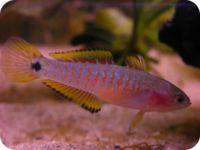Eye Spot Sleeper (Tateurndina ocellicauda)
From The Aquarium Wiki
(Redirected from Peacock Gudgeon)
Eye Spot Sleeper
Tateurndina ocellicauda
38 Litres (10 US G.)
5.1-6.4cm (2-2.5 ")
Freshwater
6.5 - 8
23.3-27.8°C (74 -82 °F)
4-14 °d
1:2 M:F
5-8 years
Family
Eleotridae
Contents
Additional names
- Eye Spot Sleeper, Peacock Gudgeon, Peacock Goby
Origin[edit]
- This fish is native to the island of New Guinea and east Papua.
Sexing[edit]
- Both sexes are equally colourful, and are most consistently distinguished by their dimorphic head shape. The males posses a blocky head shape with a small cephalic or nuchal hump, while the females head is more streamlined and many, not all, females have a black line on their anal fin. The yellow patch on a females belly also becomes more obvious when females are ready to breed, and takes on a gravid appearance. Both will be at peak colour when ready to breed.
Breeding[edit]
- See our breeding article for the Peacock Goby.
Tank compatibility[edit]
- These fish are not overly active swimmers, and a pair or trio (1M:2F) can share a 38 Litres (10 US G.). If planning for a community tank choose peaceful, small to similarly sized tank-mates that prefer the mid to upper tank levels and low water movement such as Pseudomugil gertrudae. More active species such as Rasboras are also acceptable, but may present additional challenges to feeding.
Diet[edit]
- May refuse to eat prepared food such as flakes, pellets, and even dried foods, especially if the specimens are wild caught. Live foods such as Daphnia, Bloodworm, and midge or mosquito larvae are preferred, but frozen foods should be readily accepted as well. Even if prepared food is accepted, due to the carnivorous nature of this fish supplementation with live and frozen foods is highly recommended. If kept in a community tank target feeding may be considered as these fish may not be able to compete with faster swimming fish.
Feeding regime[edit]
- Feed once or twice a day.
Environment specifics[edit]
- A true freshwater fish which inhabits the lower strata of clear ponds, gently flowing rivers and streams. Due to the natural environment of this species, moderately soft water with a neutral pH is recommended, but as long as water quality is maintained this species can live and even produce viable eggs in moderately hard (dH >12) and alkaline (pH 7.8) water. Current should be minimal, or limited to the upper levels of the tank depending on stocking as these fish are not especially strong swimmers. A sand or smooth gravel substrate is recommended, well or moderately planted, and decorated with small slate, terracotta, or PVC pipe caves for spawning.
Behaviour[edit]
- An entirely peaceful curious fish that mainly dwells in the bottom levels of the tank. Males can, however, be territorial if they are spawning.
Identification[edit]
- Although the small size, body shape, and bright colouration of this species may be reminiscent of Killifish, T. ocellicauda possesses several distinguishing characteristics:
- The body base colour consists of faintly iridescent baby blue with broken, fine-lined red vertical banding that extends into the dorsal and anal fins, and a pale yellow colouration of the belly which may be more prominent on females.
- Two dorsal fins, the second and larger of which nearly matching the anal fin in length, and featuring a vibrant yellow stripe. Some specimens may also feature black trim along the dorsal and anal fins.
- A black “eye spot”on the peduncle , which may be surrounded by yellow depending on specimen.
- Eye Spot Sleepers can reportedly grow up to 7.6cm (3"),[1] but the range of 2-2.5 in. is far more common.
Videos[edit]
| Care: | |
Precautions[edit]
- Although T. ocellicauda can tolerate a considerable range of water parameters, this species is deemed to be of moderate difficulty due to several factors that should be considered before purchase:
- Water Quality – T. ocellicauda require clean water, and have low tolerance for nitrate pollution. Mature filters and weekly water changes of adequate volume is strongly recommended.
- Feeding Challenges – Many specimens, especially those that are wild caught, will resist prepared foods by simply spitting it out after tasting, and because this species is not an especially strong swimmer who prefers mid-water feeding it is important to make sure that other tank mates are not consuming the sleepers share.
- Post-spawning Aggression – Males naturally defend their cave from any intruder after spawning until the eggs hatch, but on rare occasions this can result in injury or death to tank mates.
Pictures[edit]
References[edit]
- ↑ Baensch,H., & Riehl, R. (1993) Aquarium Atlas, vol. 2 pg. 1074. ISBN 1-56465-114-2 (USA), IBSN 3-88244-052-X
External links[edit]
- Fishbase (Mirrors:
 )
)

